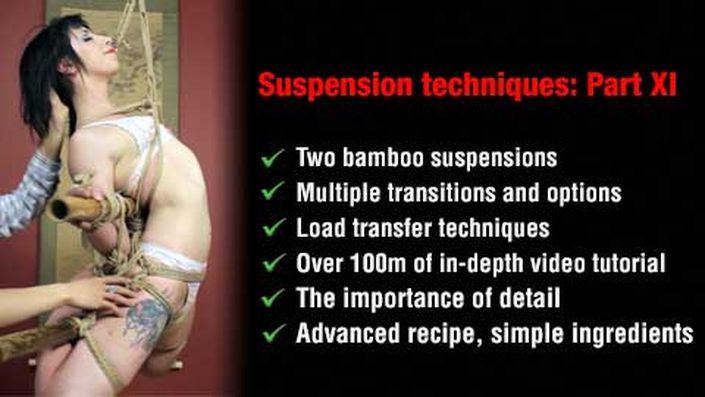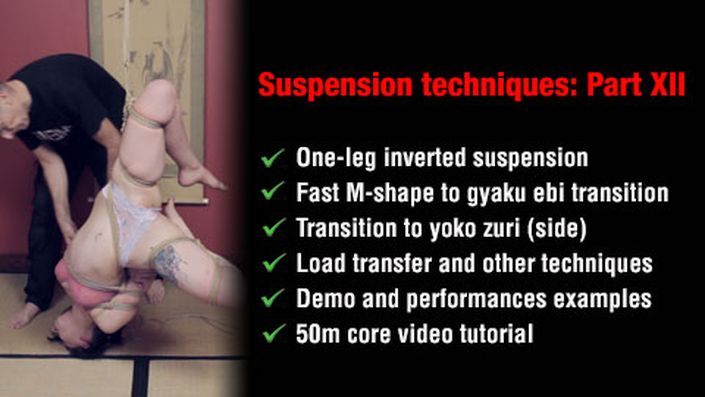
Level IV: Shibari suspension techniques
Suspension techniques: Parts X, XI & XII bundled at a discounted price
This course bundle includes next three parts of the shibari Suspension Techniques series (Parts X, XI & XII) and is the logical progression from Level III: Shibari suspension techniques. These will guide you, step by step, through some very advanced suspensions with multiple transitions.
We have also included the futo-momo tutorial, which provides other options for this element. As this is an ingredient, any flavour will do so long as it does the job. Our aim is to make you see ties as a way of achieving engineering criteria with many ways to achieve the same goal, rather than a set formula that you repeat without any creativity or flexibility. Your tying becomes bespoke to your partner, not merely 'off the peg'.
In these tutorials, you will learn:
- Inverted suspension
- Using bamboo in suspension ties
- Futo-momo based suspensions
- Additional load transfer techniques
Assuming you have absorbed the preceding tutorials, which form vital foundations, these classes will help you progress safely to the next level. If you haven't already studied the contents of the preceding tutorials, we urge you to do so for the sake of safety as these are much more advanced suspensions. As with all our tutorials, they go into a lot of depth so you understand the ingredients that you are using and how they behave. This means you will be able to spot and correct your own mistakes but, most importantly, tie with confidence, creativity and feeling.
Your Instructor

Esinem is a shibari artist who has regularly appeared at UK and international events such as Pride, Torture Garden, Erotica, Rubber Ball, Wasteland, Boundcon, Nuit Demonia and recently represented the UK at Japan's first international kinbaku event, Toubaku. He is also known for his teaching both in the UK and internationally and was co-organiser of the London Festival of the Art of Japanese Bondage and BOUND, Europe's premier monthly shibari event.
Over the last few years, he has been improving his skills in Japan with the help some of their best known and respected kinbakushi, Arisue Go, Osada Steve, Kinoko Hajime, Kazami Ranki and, grand master of newaza, Yukimura Haruki. Whilst drawing from classical methods, his style is distinctive and epitomizes the art of communicating with rope, often departing from the typical serenity of shibari shows and flying in the face of tradition to produce some striking and unusual performances.
In addition, he has worked on various videos, e.g. Primal Scream's 2013, artistic collaborations and photo shoots both on and off camera. He has been involved in projects providing inspiration for Tom Ford's 2013 collection and, Raqib Shaw, an acclaimed artist who has exhibited at the Tate, Metropolitan and White Cube galleries.
He contributed to Rope, Bondage & Power, edited by Lee Harrington and is currently involved with a number of documentaries on kinbaku. He is also author of the first English language tutorial DVDs: 'Japanese Rope Bondage: Tying people, not parcels'.
Nina Russ is a London based, shibari performer, rope artist and educator. She became student of Esinem in 2011 and their collaboration gave birth to BOUND shibari night (2012) and ShibariClasses (2015). She had also the fortune to participate at workshops with different Japanese shibari masters, like: Kazami Ranki, Yukimura Haruki, Kinoko Hajime.
She has performed internationally, most notably at the London Festival of the Art of Japanese Rope Bondage and RopeFest in St.Petersburg. In addition, she participates in numerous artistic, fashion collaborations and local performances. Her passion for rope has lead her on a route of discovery of concepts, philosophy, aesthetics and benefits behind this Japanese discipline.
She sees shibari as an art form which creates deep connection between the participants and also aids personal development. Due to its martial arts roots, it brings self-discipline, efficiency, effectiveness and, thus, growth in confidence and awareness. She believes these skills allow a greater focus on the most important aspects: you, your partner and your shared experience.
Course Curriculum
Courses Included with Purchase








